Successful Collaboration Between a Gram Panchayat and a Civil Society Organisation: A Case Study
By Debraj Bhattacharya
Abstract
Collaboration between the local government of rural India (gram panchayats) and civil society organisations (CSOs) is an unresearched area in the literature on Local Democracy in India. This paper hopes to initiate a discussion on this. It does so through a case study of a collaboration between Pradan, a CSO and the Pindarkon Gram Panchayat of Hazaribagh district, Jharkhand. The paper highlights the key interventions made as a result of the collaboration and explores the reasons behind the success of the collaborative effort.
Introduction
When the 73rd Constitutional Amendment was passed in the Parliament of India in 1992, there was no constitutional role assigned to CSOs within the framework of rural local governance in India. Over the next three decades, as local governments took root in different states of the country, there were many challenges. Some states performed better than others. Some states were enthusiastic while others were reluctant to develop local governments in their states. Local governments were also found to be lacking in ideas, experience and expertise on the tasks that were allocated to them by the Constitution. This resulted in many CSOs taking up the cause of local democracy/Panchayati Raj in India and working directly with Gram Panchayats (GPs) or indirectly through capacity building, advocacy, research and documentation to support these. PRIA, Unnati, and the Institute of Social Sciences are some notable names among such CSOs.
Unfortunately, in the existing scholarly literature on local democracy/decentralisation in India, the role of CSOs in supporting local democracy in India has not been systematically probed. There are many instances of such collaboration known to practitioners, but they have not been documented systematically. This case study hopes to initiate the process.
Methodology
Following a qualitative approach, I visited Pindarkon GP and had discussions with the Pradan team in Ranchi in November 2022. Before going to the field, I also watched a film by the Ministry of Panchayati Raj, Government of India. Data and information were gathered from onsite observations, as well as unstructured interviews and group discussions with various stakeholders, such as the Former President, Kamakhya Singh, the current President Sumita Debi, former and present ward members, staff of Help Desk, ICDS workers, health workers of the Health Sub-Centre, SHG Federation members of Padma Block, members of Jharkhand Pradesh Mukhiya Sangh, village-level social workers, Field in-charge of Pradan responsible for Pindarkon GP and state-level officials of Pradan.
The context
The Pindarkon GP is in the Padma Block of Hazaribag district of Jharkhand. There are 7 revenue villages and 14 wards. As per the 2011 Census, it has a total population of 6,815, out of which 3,510 are males and 3,305 are females. The Pindarkon GP has 1,198 people belonging to the Scheduled Caste (SC), 3,647 belonging to Other Backward Classes (OBCs), 43 to the Scheduled Tribe (ST) and 1,927 people belonging to the General category. There are 363 Below Poverty Line (BPL) families out of the total number of 1,216 households.
Table 1. Demographic profile of Pindarkon GP
| Sl. No. | Name of village | Total # of Households | Total # of males | Total # of females | Total population | Area (Ha) |
| 1. | Pindarkon | 390 | 1018 | 991 | 2009 | 528 H |
| 2. | Karar | 191 | 633 | 569 | 1202 | 180 H |
| 3. | Gotea | 112 | 314 | 317 | 631 | 270 H |
| 4. | Bardewa | 113 | 302 | 277 | 579 | 120.13 H |
| 5. | Bhandra | 239 | 652 | 615 | 1267 | 405.16 H |
| 6. | Simarkurha | 46 | 127 | 112 | 239 | 178.36 H |
| 7. | Nachanwe | 125 | 396 | 361 | 757 | 321.33 H |
Source: Pindarkon GP
The economy of this GP is primarily agrarian. Approximately 90 percent of the people are involved in agriculture. The remaining 10 percent are in jobs, government and private. The soil is fertile and irrigation facilities are available although not everywhere. Crops and vegetables are grown during the Rabi and Kharif seasons.
It is a mixed caste GP consisting of Mahatos, Sahus, Yadavs, Rajputs and Harijans. Of these, the Mahatos are in the majority. Out of three terms so far, two terms of the GP have been headed by the Mahatos.
There are nine Anganwadi centres with nine sevikas and eight sahayikas; seven primary schools with thirty-four teachers and three middle schools. There is one Health Sub-centre, one ANM and eighteen swasthya sahayikas.
Pradan and its interventions
In 1987, Pradan started working with the government as a collaborator and helped in developing country-wide programmes, such as the Integrated Rural Development Program (IRDP), Swarnajayanti Gram Swarozgar Yojana (SGSY), and National Rural Livelihood Mission (NRLM). It currently works in seven states of India (Bihar, Chhattisgarh, Jharkhand, Madhya Pradesh, Odisha, Rajasthan, and West Bengal). In these states, it works in 115 blocks of 40 districts impacting the lives of approximately five million people.
In 2013-14, Pradan recognised the following gaps in its work:
- Its achievements were specific to its project areas and did not have a larger impact on empowering the community. So, once a project was over, there was little long-term impact as the community was not permanently empowered.
- Its approach to development was largely techno-managerial. Structural issues, such as issues of power in rural society, were not addressed.
It was, therefore, decided that the new strategic thrust would comprise:
- Disseminating civic literacy
- Improving participation of women
- Promoting the Panchayati Raj Institution-Community Based Organisation (PRI-CBO) collaboration
- Strengthening PRIs as institutions
- Delivering infrastructure programmes
- Creating an information centre and help desk
- Monitoring the state of governance
 Pradan’s new strategy of intervention
Pradan’s new strategy of intervention
Accordingly, between 2015-16, a new PRI-centric initiative was launched, with 16 GPs in Jharkhand, including the Pindarkon GP, and 15 GPs in Madhya Pradesh. For this, Pradan collaborated with two other CSOs – Annode Governance Lab and We, The People Abhiyan.
A key preliminary step of the strategy was to establish a Memorandum of Understanding (MoU) with the GP.1 Following this, in 2017, the GP leaders – Mukhiya, Upmukhiya, Panchayat Samiti member and Cluster-Level Federation (CLF) leaders – were sent to Thrissur, Kerala for a week-long exposure visit. Five persons from Pindarkon were part of this visit. They specifically studied three aspects of Kerala Gram Panchayats: (a) how the GPs work as institutions, (b) quality service delivery by GPs, and (c) citizens’ participation.
During the visit, the team saw how GPs are being run as offices. They also studied the participation of Self-Help Group (SHG) networks in different stages of the planning of a GP. They observed how Kudumbashree (Kerala’s network of SHGs) functions to reduce poverty and empower women. Finally, they visited the Kerala State Finance Commission to understand their policies and devolution of funds to GPs. This exposure visit convinced the visiting GP leaders that there were several measures that they could take for the overall development of the villages.
Interventions in Pindarkon GP
Gram Panchayat Office
Until 2015, the GP office was not in a usable condition. The new Mukhiya, Kamakhya Singh, took the initiative to procure funds from the district and build the new office – a double-storied building with a large conference room, separate rooms for the Mukhiya and Help Desk; computer training centre for children; a library; sewing training centre for women and clean toilets for both men and women. The total cost was INR 14,85,000. The new GP office became fully functional in 2017.
Visioning exercise and master plan
Pradan was fortunate to get a remarkable GP Mukhiya in Kamakhya Singh, who had been a social worker and has a master’s degree in Rural Development. When he began the collaboration with Pradan and went to Kerala, he was able to quickly come up with ideas to go about his work. He realised that a visioning exercise was needed with various stakeholders to analyse the development needs of the GP. Accordingly, a three-day workshop was conducted with elected representatives, SHG federation members and various other prominent people in the locality and a Master Plan was created for five years involving activities related to agriculture, education, empowerment of women, skill development and infrastructure etc. Funding for the activities was partly available from the GP’s schematic funds and partly from various departmental funds.
Help desk (Gram Panchayat Sahayata Kendra)
The idea of a Help Desk was the result of the Kerala visit. It was realised that many villagers were either not aware of the various government schemes for them or did not know how to apply for these. Villagers also needed help with updating their ADHAAR card, applying for their NREGS job card, pension card, and ration card etc. To help them with these matters, in September 2018, a Help Desk was set up in a separate room within the GP office. Two local women were appointed to run this Help Desk and visit the villages to inform SHG members about various schemes. They received three days of training initially and then, intermittent training on a fortnightly basis once they started working. They each received an honorarium of INR 3,968 per month.
By Nov 2022, the Help Desk had assisted 232 villagers in applying for new ration cards and 297 villagers in getting their cards corrected; more than 500 new NREGS job cards were issued; 247 applications were made for the landless to get land out of which 90 were received; 650 AADHAR card rectifications and 400 new applications were made. Around 450 caste, income, and residential certificates were issued, and approximately 100 birth/death certificates were issued. A total of 45 persons were assisted in applying for the Pradhan Mantri Gramin Awas Yojana. Around 150 Disability Certificates were issued. The Sahayikas helped 120 villagers to get PAN cards, 100 villagers to open bank accounts, 600 villagers to apply for E-Sram Card, 350 villagers to apply for Labour Card, 20 girls to apply for Sukanya Samriddhi Yojana, 10 persons to apply for Kanyadan Yojana certificate and almost 150 persons were helped in getting Kisan Credit Cards.
Apart from specific benefits to individuals, the Help Desk had an impact of a more general nature. It made the villagers feel that the GP could be useful to them and, therefore, more people started to get involved in its affairs. The Help Desk also served another purpose – because of it, the GP office also remained open regularly.
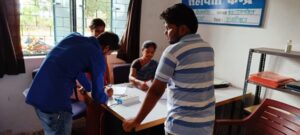 Help Desk inside Pindarkon GP office
Help Desk inside Pindarkon GP office
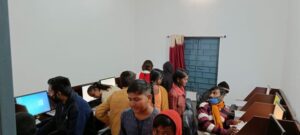 Computer Centre for Children in Pindarkon GP office
Computer Centre for Children in Pindarkon GP office
Education
To improve the quality of education, an ‘Education Core Committee’ was formed consisting of the headmasters of the schools and their School Management Committees. Regular meetings were held, and lessons were designed for students. Attendance in schools went up to 90-95 percent. During the pandemic, the GP ensured that 85 percent of the students could be reached via smartphones for online classes. Only the very poor could not be given the benefits of online education.
The GP also developed Bal Sabhas; another idea adopted from the Kerala visit. A Bal Sabha was formed in six out of seven villages. A ‘Panchayat Bal Sabha Kajkarni Samiti’ was formed consisting of three members from each Bal Sabha. They meet once a month and report on school attendance, teachers’ performance, and the quality of mid-day meals. This was done for the period before and after the pandemic. Pradan contributed by organising various trainings for the School Management Committees.
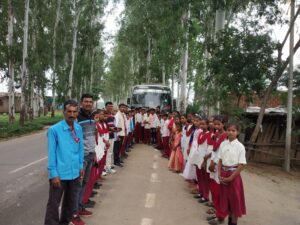 Exposure visit for students
Exposure visit for students
Model Integrated Child Development Services
The Pindarkon GP played a catalytic role in building a model Integrated Child Development Services (ICDS) centre. As the ICDS programme does not directly fall under the jurisdiction of the GP, it had to indirectly pursue relevant block and district officers for funding to build a model ICDS centre, which until then was running out of a dilapidated building. The GP organised a Gram Sabha meeting and passed a resolution, then applied to the Women and Child Development Department and followed up with the concerned officials till the centre was built. The new model centre became functional in 2021.
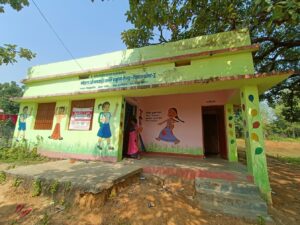 Model ICDS Centre facilitated by the GP
Model ICDS Centre facilitated by the GP
Health
An important achievement of the Pindarkon GP is the establishment of a Health Sub-centre, which started functioning in 2021. The GP played a catalytic role in this. At present, the sub-centre has OPD and child-delivery facilities. It has staff to provide medical facilities to people, however, it does not have a doctor yet. The total cost of the sub-centre was INR 14,86,000, 90 percent of which was provided by the district, and 10 percent by the GP.
During the pandemic, the sub-centre was used as an ‘isolation centre’ for migrant workers returning to the village. When the vaccine was made available, the ward members took it first to assuage the villagers’ doubts and fears about it. Awareness programmes on the use of masks and social distancing were held and food was supplied to the needy.
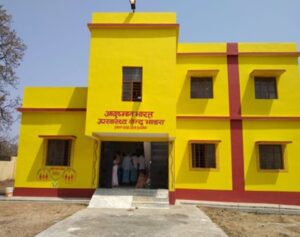 The newly-built Health Sub-centre
The newly-built Health Sub-centre
Irrigation and agriculture
The GP area had poor irrigation facilities. Pradan provided them with the technical knowledge and the Mukhiya established relations with the Minor Irrigation Department to build three check dams, two lift irrigation systems and three ponds to carry out irrigation. For the supply of electricity, an electric substation was built but needs clearance from the Forest Department. Once this substation becomes functional, 80 percent of the villagers are likely to get water for irrigation. At present, about 60 percent of the GP is irrigated.
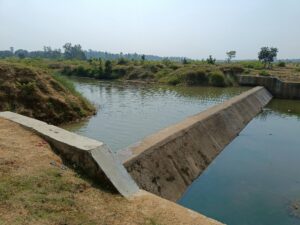 A check-dam built with Pradan’s technical support
A check-dam built with Pradan’s technical support
SHG-PRI convergence
I met the members of ‘Damodar Mahila Mandal Sangh’ of the Padma Block. The federation has 216 SHGs and 2756 members. Over a period of 20 years, they have created savings of INR 10 crore (100 million) and give loans at an interest rate of 12 percent per annum for various economic activities – agriculture, poultry, small businesses etc. They also give loans for education. The SHGs produce various items for daily consumption, like mustard oil and turmeric. These are bought within the federation and by outsiders.
However, apart from the microfinance activities, the federation is also involved in social causes. They have fought against alcoholism, witch hunting, oppression of widows, child marriages and other social evils.
The federation has maintained an active linkage with GPs, such as Pindarkon. When asked, why the GPs are useful to them, they replied that through the GPs they are able to access various government schemes. In fact, the Help Desk connects the SHGs at the village level with the GP. This helps bridge the last mile.
Bal Sabha
Although Pindarkon is not a pioneer in this experiment of involving teenagers in creating social change, it was able to successfully implement this by forming a Bal Sabha 2 or Children’s Panchayat.
After the formation of the Bal Sabha, a visioning exercise was carried out. It was decided that the GP would be a ‘child-friendly gram panchayat’ with the active participation of children. Several activities were listed in an action plan. The children of the Executive Committee of the Bal Sabha regularly meet the PRI leaders and update them about their demands, challenges and plans of action. The children assisted the GP in successfully organising various quiz and sports competitions and children who did well in these competitions were felicitated by the GP. More importantly, the Bal Sabha raised issues related to teachers and schools, such as frequent use of mobile phones inside classrooms, the Mid-Day Meal menu not being followed, or issues related to drinking water and toilets. In response to these matters, the GP issued written orders to teachers and in some cases, even advised the Head Teacher in the Core Committee meetings of the GP. Bal Sabha members motivate students to attend school regularly. They visit them door-to-door, interact with their parents and convince parents to send their children to school regularly. As a result of this, the Mid-Day Meal was regularly monitored and water and toilet facilities in schools were ensured by the Pindarkon GP. Furthermore, the children have also prepared a plan to improve the living conditions of the village. They have initiated a campaign for cleanliness and restoring its forested area (village-level plantation). The children have also chosen to deepen their understanding of constitutional values. Each Bal Sabha identified one constitutional value from the Preamble to build an understanding of it. They carried out a study covering different sections of society to understand the actual practice of the value.
Resource mobilisation
A key innovation introduced by the Pindarkon GP and Pradan was in the area of fund mobilisation. In April 2017, a three-day visioning exercise was carried out, which was attended by all elected representatives, leaders of voluntary organisations, and experts from Pradan. They collectively identified several sectors that required the GP’s intervention. However, funds that was directly available to the GP were not adequate for achieving many of the tasks – either there were not enough funds, or the guidelines did not permit such activities. So, it was realised that the GP would have to play a catalytic role in harnessing the funds available from various line departments. Accordingly, a study was undertaken to find out the different schemes and benefits available to the people of the GP. Good relations were established with the block administration and district administration and through this, the funds available under various line department schemes were brought to the GP. Two outstanding examples of this were the Health Sub-centre and the model ICDS Centre. In both cases, the GP did not have its own funds but coordinated to get funds from the higher-level administration.
Replication
Following the success of the initial piloting, the work of creating beacon panchayats has been extended since 2020 to 112 GPs of 18 blocks in 6 districts of Jharkhand – Bokaro, Hazaribag, Lohardaga, Khunti, Gomla, and West Singhbhum. The HR cost per GP is roughly one lakh per annum apart from the cost of various training programmes. A total of 30 executives have been trained to replicate the model.
Gaps and future challenges
Although Pindarkon has achieved a lot in five years and has won an award from the Government of India, some institutional shortcomings that most other Jharkhand GPs also face, persist. For example, it does not have a dedicated Secretary and shares one with another GP. The newly elected Mukhiya candidly mentioned that she is not aware of any of the software systems that the GP must use to report on the schemes and is totally dependent on someone who sits at the block level to operate these programmes, like the e-gram swaraj. It was also not clear as to who regularly maintains the accounts. The GP also suffers from the fact that the Government of Jharkhand has not as yet passed the rules according to which ‘own source revenue’ can be collected. These are problems that the Pindarkon GP will have to overcome in the coming years, and the absence of its exceptional former leader will be greatly felt.
Conclusion
The success of the Pindarkon GP perhaps can be attributed to two factors. First, the knowledge and the social capital that Pradan offered to a group of rural people, who lacked exposure to the best in local governance in the country. Pradan organised the exposure visit to Kerala, gave trainings on various issues, and allocated dedicated staff for the improvement of the GP. However, it would be a mistake to think that the creation of this beacon panchayat, which won a national award, was only the work of Pradan. Rather it is a case of successful collaboration. Secondly, the GP was led by a remarkable leader, Kamakhya Singh. He used his background in social work to build a team and establish good relations with various government departments as well as Pradan. As a result, he was able to achieve many things over which he did not have direct control. For example, one may consider PMAY (Pradhan Mantri Awas Yojana). It is the block and not the GP that has direct control over this housing scheme. However, Kamakhya Singh was able to link the beneficiaries to the relevant block-level officers and ensure that the beneficiaries got the funding. This method was followed for the ICDS centre as well as the Health Sub-centre. It was interesting to see him being welcomed in the GP meeting by the new Mukhiya who belongs to a different political group. My very first meeting was attended by both the new Mukhiya, Sumita Debi as well as the former Mukhiya, Kamakhya Singh.
Kamakhya Singh’s success points towards the need for developing a leadership style among the elected Presidents of Gram Panchayats of India, where the leader is a consensus builder and has the ability to build relations with different types of stakeholders – villagers; CBOs; grassroots workers, like ASHA and health workers; as well as block-level officials and NGOs. The President of a GP needs to be an efficient facilitator rather than a macho ‘neta’.
Acknowledgement: I would like to thank Professor Ashok Kumar Sircar for his valuable comments on the first draft of the paper. The fieldwork in Pindarkon GP was facilitated by Mr Dhiraj Mahato of Pradan and supervised by Mr Sukanta Sarkar of Pradan. Without their support, the fieldwork would not have been possible.
Author
Debraj Bhattacharya, Centre for Local Democracy and School of Development, Azim Premji University

